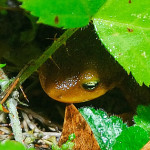 Yesterday’s rain brought out another salamander species here at Curbstone Valley, the Coast Range Newt (Taricha torosa torosa), also known as the California Newt. Each year, as the rains return, these newts can be seen scrabbling about the forest, and occasionally crossing the roadway as they travel toward the creek.
Yesterday’s rain brought out another salamander species here at Curbstone Valley, the Coast Range Newt (Taricha torosa torosa), also known as the California Newt. Each year, as the rains return, these newts can be seen scrabbling about the forest, and occasionally crossing the roadway as they travel toward the creek.
This newt is native to California, and as its name implies, is found primarily along the coast.
The Coast Range Newt shares its habitat range with the Rough Skinned Newt (Taricha granulosa) from Santa Cruz county north to Mendocino. These species are often confused, as they are very similar in appearance, brown dorsally, and bright orange ventrally. One distinguishing characteristic is that the eyes appear to extend to or beyond the outline of the head for the Coast Range Newt when viewed from above, unlike the Rough Skinned Newt.
Newt larvae are aquatic, and young transform to the terrestrial phase, moving onto land, in late summer to early fall. In spring, dozens of newts can often be seen in the slow moving pools along the edge of our creek bank. Following metamorphosis, the young newts emigrate from the breeding site and spend the next few years on land growing to sexual maturity.
Adult Coast Range Newts are terrestrial, and become aquatic when breeding. They may be observed in large numbers when migrating toward aquatic breeding sites during or after rains during breeding season.
Adults enter ponds, reservoirs, and sluggish pools in streams to breed, typically beginning in December or January, with the first heavy rains. Coast Range Newts leave their aquatic habitat within a few weeks of breeding, and estivate terrestrially during the dry summer, residing in moist habitats under woodland debris, animal burrows, or in rock crevices. This species has been documented migrating approximately 2 miles between breeding and estivation sites.
Adult newts grow to approximately 8 inches in total length, and unlike the California Slender Salamander that also resides here at Curbstone Valley, they have lungs, rather than breathing through their skin.
The diet of Coast Range Newts primarily consists of earthworms, snails, slugs, sowbugs, bloodworms, mosquito larvae and other invertebrates.
The lifespan for this species is unknown, but is presumed to be in excess of 20 years based on knowledge of a similar species, the red-bellied newt (Taricha rivularis).
When threatened, the Coast Range Newt will assume a swaybacked defensive pose known as the unken reflex, common to other Taricha species, exposing its bright ventral surface to warn off potential predators. If this defense mechanism fails, Coast Range Newts, like other members of the Taricha genus, secrete tetrodotoxin, a neurotoxin that is significantly more potent than potassium cyanide. This is the same toxin found in pufferfish. If ingested in sufficient quantity, this can cause death in most vertebrates, including humans. Tetrodotoxin binds to voltage-gated sodium channels, disabiling ion channel function, which in turn leads to paralysis of the diaphragm, causing respiratory failure.
The Rough-Skinned Newt (T. granulosa) is the most toxic salamander worldwide, with the Coast Range Newt (T. torosa torosa) being about 1/10th as toxic as its cousin. The newt larvae however are not poisonous. Regardless, due to this toxicity, the Coast Range Newt has few natural predators. Gartersnakes are their most common predator. Remarkably the common gartersnake (Thammnophis sirtalis) that preys on the Rough-skinned Newt has been shown to have developed a genetic resistance to tetrodotoxin.
This newt species, one of five in California, is in decline, and Coast Range Newt populations south of the Salinas River in Monterey County are considered by the California Department of Fish and Game to be Species of Special Concern (DFG_SSC). Some populations have been greatly reduced in southern California coastal streams due to the introduction of non-native, invasive species such as mosquito fish and red swamp crayfish that prey on eggs and larval stages. Human habitat encroachment, including road-kills along migration routes, is also contributing to their decline.












I always liked newts and salamanders; they’re so cute and unusual. This was a very informative post; there were a lot of things that I apparently did not know about them!
Thanks for stopping by Sylvana. I often find that some of our smaller, more often overlooked, inhabitants of the farm are the most interesting to learn about 🙂